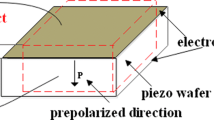Abstract
Piezoelectric (PZ) actuator is widely recognized for its high precision and displacement accuracy even at nanometer ranges. A minimalistic model is proposed in the present work, for PZ stack actuators. In the proposed model, various stack assembly arrangements have been assumed. Separate series and parallel assembly arrangements are suggested for both mechanical and electrical parts of the PZ actuators. The linearized constitutive equations formulated by IEEE, is considered to take into account the electromechanical coupling of the PZ actuator.
In the proposed model, stiffness of the connectors in stack assembly have also been taken into account and is modeled as connector spring. To include the effects of connector spring, the relationships of force and voltage with actuator displacement is replaced by the relations between force and voltage with the displacement of point of actuation at the physical system. This leads to a more realistic model of PZ actuator to be used in applications requiring actuator to be modeled as a black-box. With the advent of technology, more and more complex and compact actuating system are emerging into existence. Engineering applications, such as in the field of robotics, that require a black-box modeling of actuators, need simplistic models of the actuators to decrease the computational complexity. The proposed model, being a minimalistic one, qualifies as an ideal candidate for such applications.
Access this chapter
Tax calculation will be finalised at checkout
Purchases are for personal use only
Preview
Unable to display preview. Download preview PDF.
Similar content being viewed by others
References
Goldfarb, M., Celanovic, N.: Modeling piezoelectric stack actuators for control of micromanipulation. IEEE Control Systems 17(3), 69–79 (1997)
Adriaens, H., De Koning, W., Banning, R.: Modeling piezoelectric actuators. IEEE/ASME Transactions on Mechatronics 5(4), 331–341 (2000)
Gu, G.-Y., Zhu, L.-M., Su, C.-Y., Ding, H.: Motion control of piezoelectric positioning stages: modeling, controller design, and experimental evaluation. IEEE/ASME Transactions on Mechatronics 18(5), 1459–1471 (2013)
Chee, C.Y., Tong, L., Steven, G.P.: A review on the modelling of piezoelectric sensors and actuators incorporated in intelligent structures. Journal of Intelligent Material Systems and Structures 9(1), 3–19 (1998)
Irschik, H.: A review on static and dynamic shape control of structures by piezoelectric actuation. Engineering Structures 24(1), 5–11 (2002)
Chopra, I.: Review of state of art of smart structures and integrated systems. AIAA Journal 40(11), 2145–2187 (2002)
Anton, S.R., Sodano, H.A.: A review of power harvesting using piezoelectric materials (2003–2006). Smart Materials and Structures 16(3), R1 (2007)
I.E.E.E. Standard on Piezoelectricity: An American National Standard, ser. I.E.E.E. Transactions on sonics and ultrasonics. IEEE (1987)
Croft, D., Devasia, S.: Hysteresis and vibration compensation for piezoactuators. Journal of Guidance, Control, and Dynamics 21(5), 710–717 (1998)
Dimmler, M., Holmberg, U., Longchamp, R.: Hysteresis compensation of piezo actuators. Tech. Rep. (1999)
Ang, W.-T., Garmon, F., Khosla, P., Riviere, C.: Modeling rate-dependent hysteresis in piezoelectric actuators. In: Proceedings of the 2003 IEEE/RSJ International Conference on Intelligent Robots and Systems (IROS 2003), vol. 2, pp. 1975–1980 (October 2003)
Deng, L., Tan, Y.: Modeling of rate-dependent hysteresis in piezoelectric actuators. In: IEEE International Conference on Control Applications, CCA 2008, pp. 978–982. IEEE (2008)
Xu, Q.: Identification and compensation of piezoelectric hysteresis without modeling hysteresis inverse. IEEE Transactions on Industrial Electronics 60(9), 3927–3937 (2013)
Seki, K., Ruderman, M., Iwasaki, M.: Modeling and compensation for hysteresis properties in piezoelectric actuators. In: 2014 IEEE 13th International Workshop on Advanced Motion Control (AMC), pp. 687–692 (March 2014)
Mohammadzaheri, M., Grainger, S., Bazghaleh, M.: A comparative study on the use of black box modelling for piezoelectric actuatorssome other works. The International Journal of Advanced Manufacturing Technology 63(9-12), 1247–1255 (2012)
Mohammadzaheri, M., Grainger, S., Bazghaleh, M.: Fuzzy modeling of a piezoelectric actuator. International Journal of Precision Engineering and Manufacturing 13(5), 663–670 (2012)
Canfield, S., Frecker, M.: Topology optimization of compliant mechanical amplifiers for piezoelectric actuators. Structural and Multidisciplinary Optimization 20(4), 269–279 (2000)
Datta, R., Deb, K.: Multi-objective design and analysis of robot gripper configurations using an evolutionary-classical approach. In: Proceedings of the 13th Annual Conference on Genetic and Evolutionary Computation, pp. 1843–1850. ACM (1850)
Sui, L., Xiong, X., Shi, G.: Piezoelectric actuator design and application on active vibration control. Physics Procedia 25, 1388–1396 (2012)
Borodinas, S., Vasiljev, P., Mazeika, D.: The optimization of a symmetrical coplanar trimorph piezoelectric actuator. Sensors and Actuators A: Physical 200, 133–137 (2013)
Datta, R., Pradhan, S., Bhattacharya, B.: Analysis of a seven link robot gripper with an integrated piezoelectric actuation system. In: Proceedings of the 13th International Conference on Control, Automation, Robotics and Vision, ICARCV 2014 (2014)
Keoschkerjan, R., Wurmus, H.: A novel microgripper with parallel movement of gripping arms. In: Proceedings of 8th International Conference on New Actuators, pp. 321–324 (2002)
Author information
Authors and Affiliations
Corresponding author
Editor information
Editors and Affiliations
Rights and permissions
Copyright information
© 2015 Springer International Publishing Switzerland
About this paper
Cite this paper
Jain, A., Datta, R., Bhattacharya, B. (2015). Unified Minimalistic Modeling of Piezoelectric Stack Actuators for Engineering Applications. In: Kim, JH., Yang, W., Jo, J., Sincak, P., Myung, H. (eds) Robot Intelligence Technology and Applications 3. Advances in Intelligent Systems and Computing, vol 345. Springer, Cham. https://doi.org/10.1007/978-3-319-16841-8_42
Download citation
DOI: https://doi.org/10.1007/978-3-319-16841-8_42
Publisher Name: Springer, Cham
Print ISBN: 978-3-319-16840-1
Online ISBN: 978-3-319-16841-8
eBook Packages: EngineeringEngineering (R0)




